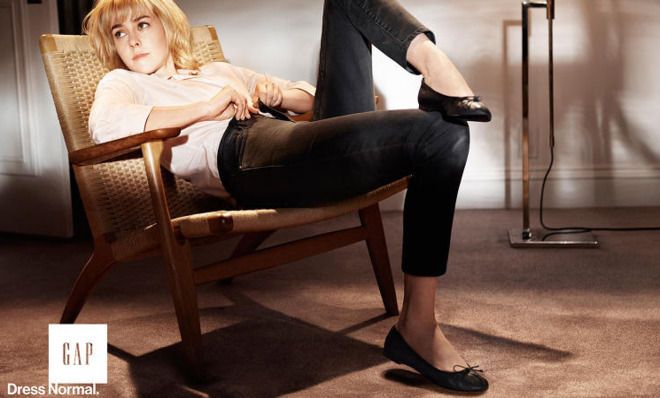How income inequality invaded high fashion
The elite turn to understatement in the age of Piketty


The biggest fashion story of this year isn't Rihanna's see-through dress or candy-colored hair. It is normcore, a phrase coined by trend forecasting collective K-Hole to describe the phenomenon of cool kids dressing more like regular folks: Think fleece jackets and roomy jeans. As reported by New York, trying to look different and authentic is now out. Sameness is in.
Though I doubt we'll see Anna Wintour in Costco khakis anytime soon, it does appear that she, along with the other editors, stylists, and designers who make up the fashion elite, got the message.
I read every page of every major September issue on the market — yep, that is about 15 pounds of fashion magazine — and if there is one prominent theme running through them, it is a call for subtlety. Don't get me wrong: There are still layouts dedicated to bold prints and fur coats. But the most consistent message threading its ways through the thousands of glossy pages is that we should all try dressing more normal.
The Week
Escape your echo chamber. Get the facts behind the news, plus analysis from multiple perspectives.

Sign up for The Week's Free Newsletters
From our morning news briefing to a weekly Good News Newsletter, get the best of The Week delivered directly to your inbox.
From our morning news briefing to a weekly Good News Newsletter, get the best of The Week delivered directly to your inbox.
Vogue declares: "Fashion at large is readjusting, grounding itself in different sensibilities — not the tired fantasy of taking a limo from the house to red carpet, but rather the idea of walking in the streets and riding the subway. Casual. Real." They go on to describe the global shift toward "practical, street-style clothes elevated in desirable and affordable ways."
In Harper's Bazaar, we learn about how Victoria Beckham is ditching the stilettos for flats and that the bag of the season is "minimalist… utterly plain," and "a paradigm of understated timelessness" that is "the real signature of this season."
And in Elle, there is an essay on the merits of bourgeois chic as a normcore alternative for the over-25 crowd. "Similar impulses are behind both sartorial modes: to pare down, to streamline, to spurn the herd mentality of trend chasing, the fallacy that individualism can be bought, and the waste and clutter of fast fashion." What follows is a series of profiles of designers whose look is understated and clean.

Even the mass-market Gap has gotten into the spirit. Its fall campaign encourages all of us to "Dress Normal" and let "our actions speak louder than our clothes."
A free daily email with the biggest news stories of the day – and the best features from TheWeek.com
The clothes behind the look include oversize knit sweaters, neat-fitting button-downs, ankle-grazing skirts, shift dresses, and oxford shoes, all in muted colors.
So what to make of fashion's new appreciation of normal?
In a way, this shift in high fashion is a more honest approach to dressing than normcore, which is just another example of the elite, this time the creative class, appropriating the look of another less empowered group, middle-class Midwesterners. (By empowered, I am referring to their cultural clout, not their overall worth.)
In L.A. Weekly, longtime "normal" dresser Isaac Simpson describes it similar to a "noble savage myth — that those unaware of the eye of mainstream society are the most beautiful of all," and says he resents it feels like "a big fat hipster laugh in my face: 'We even do normal better than you.'"
Fashionistas, on the other hand, aren't claiming that they're above the materialistic fray or fetishizing the way another group dresses. Instead, they are just lowering the bar for themselves, and therefore for all of us, with a look that is less dependent on a trust fund or a personal trainer. The new "normal" is a signal that being different is no longer the goal.
This is a welcome shift from the more competitive and expensive approach of recent years, when trends moved at lightning speed and the emphasis was on standing out through skintight dresses and boldly labeled handbags, which feel more and more out of place in the light of growing awareness of income inequality. With Thomas Piketty's Capital in the 21st Century still on best-seller lists and New York City’s new spate of mixed-income housing developments, it is becoming harder for the fashionable rich to deny their disproportionate wealth.
It's unsurprising, then, to see echoes of today's fashion in the way the Great Depression altered tastes in the 1930s. Then, fashionistas opted for simpler, more timeless styles that cloaked their wealth better than the freewheeling fashion of the 1920s. Then, too, the fashion tastes of high and low converged. As Deborah Cohen writes for The Atlantic:
The streamlined style of the 1930s was, well, tailor-made for a self-conscious era. This was elegance for people who didn't want to stand out: inconspicuous consumption for the rich few and inexpensive good taste for the newly hard-pressed middle class, desperate to keep up appearances. [The Atlantic]
We see a similar phenomenon today. Quieter clothing still allows women to message their relevancy to those in the know while keeping them from sticking out in a world where people who make a very un-livable minimum wage roam.
And yet, there is reason to not get too carried away in praising fashion's self-awareness. When the latest styles are available at stores like Zara and H&M weeks after appearing on the runway, eschewing all things trendy and fast is just another way to establish one's elite credentials. After all, understatement can still be a statement.
Elissa Strauss writes about the intersection of gender and culture for TheWeek.com. She also writes regularly for Elle.com and the Jewish Daily Forward, where she is a weekly columnist.
-
 11 hotels opening in 2026 to help you reconnect with nature
11 hotels opening in 2026 to help you reconnect with natureThe Week Recommends Find peace on the beaches of Mexico and on a remote Estonian island
-
 Zimbabwe’s driving crisis
Zimbabwe’s driving crisisUnder the Radar Southern African nation is experiencing a ‘public health disaster’ with one of the highest road fatality rates in the world
-
 The Mint’s 250th anniversary coins face a whitewashing controversy
The Mint’s 250th anniversary coins face a whitewashing controversyThe Explainer The designs omitted several notable moments for civil rights and women’s rights
